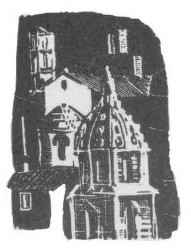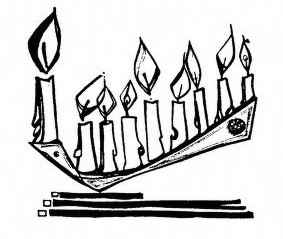
|
|
[Page 24 – English]

The Hassidim Establishes itself at Ostrowiec
Ostrowiec had the honour to receive the visit of the Baal-Shem-Tov, when he stayed at Apt with Rabbi Shabetai, the bookbinder. According to a legend popular with the Hassidim, the Baal-Shem-Tov visited with Rabbi Shabetai when “he danced with his wife on one of the Sabbath-eves” and the Baal-Shem-Tov blessed him in his old days with a son. A year later, in the year 5497, the son was born and was later known as – Rabbi Israel, “the Magid from Korzenic”. For the second time the Baal-Shem-Tov came to Apt to serve as Godfather to the newborn son who was named Israel in honour of the Baal-Shem-Tov. On the occasion, and perhaps also on both occasions, the Baal-Shem-Tov visited the neighbouring communities, and amongst them also Ostrowiec. The Baal-Shem-Tov's visit in Ostrowiec remained deeply engraved on the hearts of the Jews of the town and created many legends which endured as long as the Jewish community lasted.
Rabbi Israel, the Magid of Korzenic, felt strongly tied to Ostrowiec which was near Apt, his place of birth. Age the age of 13 he came to Ostrowiec to study at the Yeshiva of the Gaon R'Yehezkel (the father of the author of the Questions and Answers book “Mount Carmel”). In the books of the community it is noted that the boy Israel studied at the old beth-hamidrash and after midnight would fast on top the hill, which was covered with pieces of combs thrown away by the comb-workshop which considered the hill a rubbish-heap. The boy did not stay long in town, as his rabbi and teacher, R. Yehezkel, died in the year 5710; however, after his marriage, he came back and stayed there for some time. His sympathy to Ostrowiec was shared also by his son, R' Moshe brie, who had the diploma of religious justiceship of the town of Ostrowiec.
With the passage of time, Ostrowiec became a purely Hassidic town, full of Has-
|
[Page 25 – English]
|
|
[Page 26- English]
sidic prayer houses. Every Jew was connected with some 'Tsadik' and used to pray in his 'Stibl'. There were 'Stibls' of the Lublin Hassidim, of Hassidim from Alexander, Worka, Skernewic, Kuzmir, Bialobrzeg, Modrzyc, Szydlowce, Orzerow, Porysow, Gur and others.
Industrial Plants in Ostrowiec and Vicinity
The development of industry in Poland came late compared to that of Western or Central Europe. But as soon as the first buds of the factories opened in Poland, Ostrowiec at once took the lead
|
|
|
|
and soon became one of the industrial centers of the country. The demand for iron necessary for manufacture of machines, which made itself more pronounced in the beginning of the 19th century, resulted in the establishment of big foundries close to Ostrowiec, where iron ore was plentiful. The 'Pitsburg' of Poland – so named by the inhabitants – was surrounded by tall chimneys decorating the town's horizon with their smoke high up in the skies.
Nature was good to Ostrowiec, its beauty and riches were there, and into the bargain, a narrow river, Kamien, on the right side, which river was mentioned in the Jewish religious documents, marriage contracts and divorces; on the left side, the wide river Lias. Over and above it the long bridge, leading to the station and to the village Klimkowicz – with its big iron foundries and bronze foundries, employing thousands of workers; and with other big industrial plants. In Ostrowiec proper there were plants for production of cement, sugar, vinegar, soap, brandy, big iron industry with tens of
[Page 27 – English]
|
|
thousands of workers working in three shifts: a factory of railway carriages, a plant of burnt bricks, flour-mills, lumber-mill, tannery, beer-brewery, clay quarry, etc. The entire industry developed in the last 100 years. Also in the vicinity big industrial plants were built.
The Klimkowicz village, on the shore of the Kamien River, one kilometer distant from Ostrowiec, was famous for its iron plant, owned by the Baron Shmuel-Leopold Antoni Frenkel, the man who had started the conversion trend in the wealthy Jewish families at the time of the Warsaw Duchy. He changed his religion along with his children and wife, Ita-Otalia, the daughter of Shmuel Zbitkower. The Baron Shmuel-Leopold was the owner of the biggest bank in Poland. On the shores of the Kamien River is situated also the village Bodziechow, owned by the secretary of the Great Crown, the noble Jacek Malachowski, and later on sold to the Kuskowski family. In the village, there were several foundries of various metals and 5 iron ore quarries. The furnaces burned day and night and y8ielded tens of thousands tons of iron per month. In the former century there were 5 Jews amongst the 413 villagers.
On the shore of the same river there is also the village Czenstoszyce, with a sugar factory, two iron manufacturing plants, a factory of porcelain, iron ore quarries, quarries of fire-resistant clay, two flour mills, etc.
The town Dankow, on the River Kamien, which was formerly named Miechow, was known for its potters, weavers, shoemakers, dish-makers etc. In 1851, a factory was opened for stonew3are and porcelain bricks. There were 578 inhabitants with 17 Jews.
Amongst the places of the region, the village Ostrowka (or Ostrowek) is noteworthy because amongst its Christians there resided the Jew Lipa Baumstein (called Ostrowker) who was famous for his generosity towards the Jewish communities of the region. In the beginning of the First World War, in 1914, when the Russians retreated from Ostrowiec to the Vistula River, Lipa bought of them,
|
|
[Page 28 – English]
for lots of money, the various Torah books and other holy Scriptures which they captured in the city. Before his death, he wrote in his testament that he bequeathed 40,000 zloty for completion of the wall around the cemetery of Ostrowiec, and 20,000 zloty for a hostel for the Yeshiva boys of Ostrowiec.

Changes Under the Russian Government
In 1813, after the defeat of Napoleon's armies, the entire Warsaw country came under the jurisdiction of Tsar Alexander the First. The Ostrowiec community likewise had to change over several times from one authority to another, undergoing all the changes entailed.
In 1827, the overall number of Polish Jews reached 377,754 and the Jewish inhabitants of Ostrowiec, of that time, numbered 1064 equaling 57% of the entire population of the town. The Ostrowiec Jews were at that date in majority. In 1856, according to a survey of the population, there were in Ostrowiec 2685 Jews, forming 80% of the entire population thereof.
Whence came the livelihood of the Ostrowiec Jews? Owing to limitations prevalent at that time, which prevented them from entering the industry and agriculture, they concentrated on some branches of the trade and craftsmanship, and also brokerage and agencies. Most of the Ostrowiec Jews were small merchants, shop-keepers, peddlers and craftsmen. The Jewish society was homogeneous in its way of life and tradition, but variegated as regards the cultural level. There were rabbis, justices, butchers, Melamdim, Yeshive-boys, and house-owners who knew books, and centered around the beth-hamidrash; then there was the biggest selection 'Amkho': the simple people, the crowd, who found their natural milieu in the various circles of the craftsmen.
The Ostrowiec Jews, amongst whom the craftsmen were more numerous than the merchants, relaxed in joy when the borders of Russia were opened. They now could widen the markets for their produce and enlarge their income. One of the elders of the town said that the
|
|
[Page 29 – English]
craftsmen of the town limited themselves to only a few branches of crafts. Over 50% were clothes' manufacturers, especially tailors, furriers and hat-makers. Like in all Jewish townlets, in Ostrowiec there were groups of Jewish musicians, entertainers and singers. The 'Hazan' also counted amongst the musicians, and often he used to joint hem during various happenings in the life of the community.
|
|
JewishGen, Inc. makes no representations regarding the accuracy of
the translation. The reader may wish to refer to the original material
for verification.
JewishGen is not responsible for inaccuracies or omissions in the original work and cannot rewrite or edit the text to correct inaccuracies and/or omissions.
Our mission is to produce a translation of the original work and we cannot verify the accuracy of statements or alter facts cited.
 Ostrowiec Świętokrzyski, Poland
Ostrowiec Świętokrzyski, Poland
 Yizkor Book Project
Yizkor Book Project
 JewishGen Home Page
JewishGen Home Page
Copyright © 1999-2026 by JewishGen, Inc.
Updated 26 Oct 2013 by LA